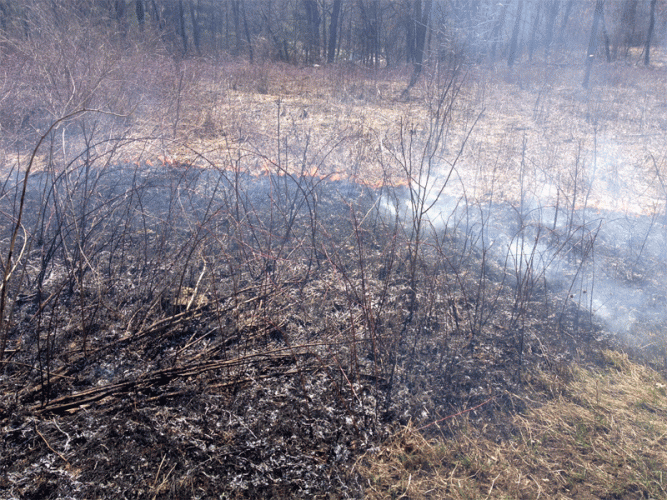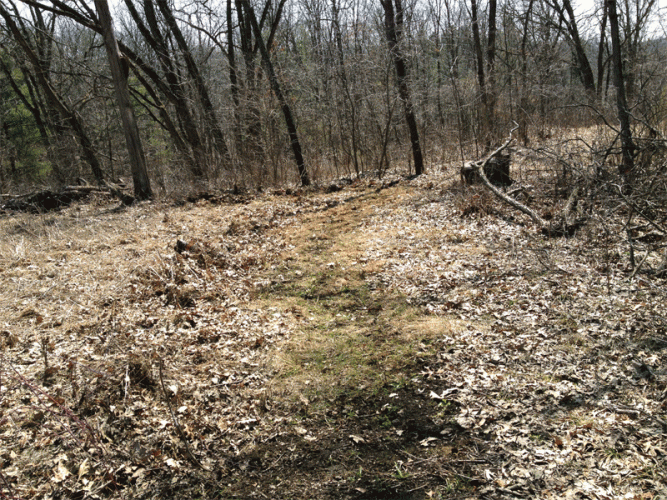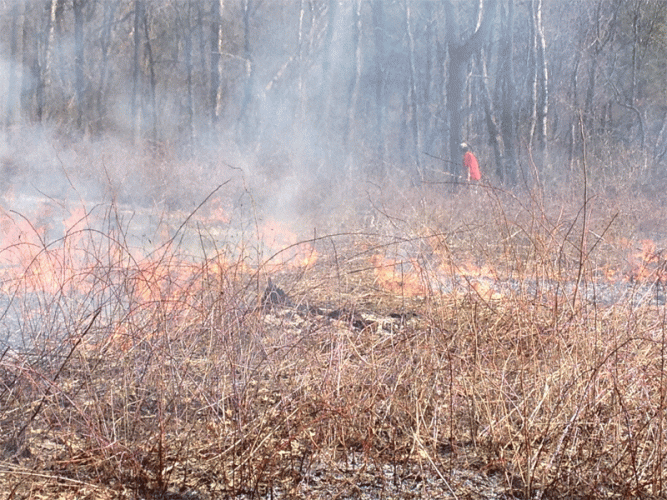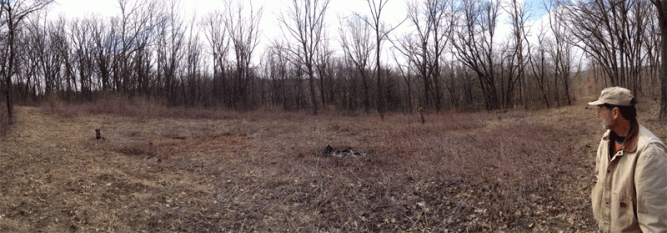Last Sunday we woke to a clearing sky. We drank our morning tea in the sunshine while rechecking the weather report. We had expected Sunday to be the first of a string of rainy days, but the rain was postponed.
This was a chance we had not expected to get. A chance to burn our prairie glade. (see my post Painting with fire and prairie plants )
I dug out my burn class notes.
- The wind was gentle and out of the southwest. That’s good. Wind above 15-16 mph can whip flame heights above 4 feet high, which is the limit of what can be managed with hand equipment.
- The humidity was 40%. Also good. Optimum humidity for a burn is 25-60%
- The temperature in the 40s was good.
- A string of sunny days had dried the leaves on the glade floor, while the ground under them was still damp. That was good too.
Only one thing was not so good – my health. I had been planning to spend Sunday mostly in bed. I was a few days into a really bad cold with a brutal, punishing cough. I knew I would pay for going out and burning instead of resting (and I have ), but how could I resist the opportunity to give the glade a good burn?
Burning prairies takes a convergence of circumstances, including all the weather conditions listed above as well as having people available at the right moment. We have not been able to burn the glade for several years, and as a result more and more invasives have been muscling their way in and crowding out the original prairie plants.
Time to turn the tables!
We made our burn plan. The goal was to burn the west and east ends and leave the center unburned. It’s important to leave some area unburned to protect the invertebrate population. Leaving the center open will give the invertebrates a chance to repopulate in both directions. Next time, we’ll burn the center, and the invertebrates can fill in from both sides.
 Step one: rake a good break around the perimeter. I took that task, and it just about did me in, but I paced myself and kept raking. Doug hunted through the barn to gather and bring up all our burn equipment: backpack water tanks, flappers, and drip torch. It took a while to find them all. Our barn has been part of the building site, and very few things are in their place after a year of construction.
Step one: rake a good break around the perimeter. I took that task, and it just about did me in, but I paced myself and kept raking. Doug hunted through the barn to gather and bring up all our burn equipment: backpack water tanks, flappers, and drip torch. It took a while to find them all. Our barn has been part of the building site, and very few things are in their place after a year of construction.
 We waited to light up till about 2 p.m. The sun had been warming the dead plant material and the breezes had been drying it. We set a little test fire which burned slowly but steadily, so we started the back burn against the wind.
We waited to light up till about 2 p.m. The sun had been warming the dead plant material and the breezes had been drying it. We set a little test fire which burned slowly but steadily, so we started the back burn against the wind.
The wind dropped below the predicted levels and began to play with us. Low wind shifts direction a lot and made the burn a little more free form. Also because we were working with almost too damp ground, it burned in patches. The flames were never very vigorous and were always easy to control.
 It feels so good to have given the glade what it needs to start the summer right.
It feels so good to have given the glade what it needs to start the summer right.
At our first opportunity (i.e. when the rain stops) we’ll mow down the brambles that didn’t burn, and watch spring come to our prairie glade.
Categories: Ecosystem Restoration, TALES FROM OUR 44 ACRES

You guys are obviously trying to do a LOT of things right, so I am definitely cheering for you.
But have you considered alternatives to burning? I know you may personally not want to eat cows, goats, or sheep, and I respect that decision, but proper use of livestock in a way that simulates natural herds with predators (in other words, tightly packed, but moved every 1 to 3 days) would be a lot nicer for your air and would probably accomplish your goal of new growth and renewal.
Livestock can either be part of the problem, or part of the solution, depending on how you graze them.
Here’s a good talk on this by Allan Savory.
Keep up the good work.
A similar point is made by Tom Chapman, but in regards to improving soil structure in the wheat belt of the UK. He also mentions the herds of bison and the effects they have on the prairie grasses
http://www.pasturepromise.tv/news.php?id=3